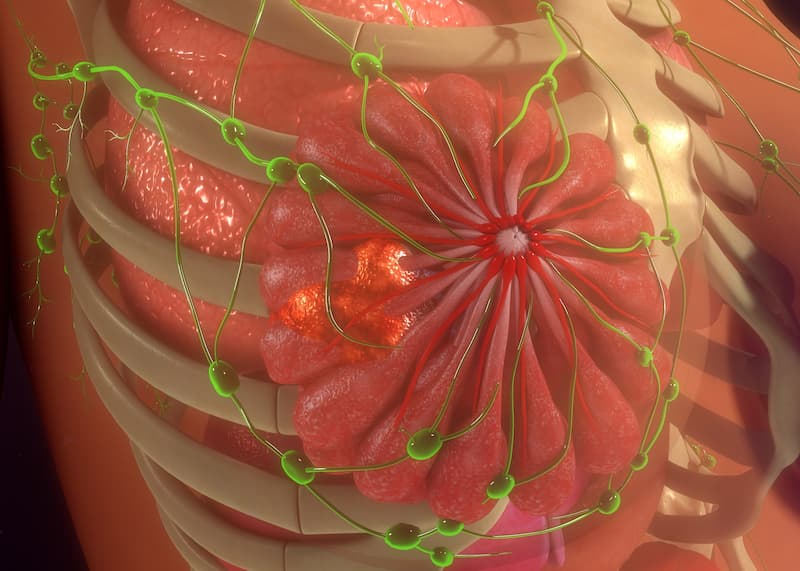Neratinib Combo Yields Meaningful Benefit in HR+ HER2-Mutant Breast Cancer
Responses in patients with hormone receptor–positive, HER2-mutated breast cancer who crossed over to receive neratinib plus fulvestrant and trastuzumab support the necessity of neratinib in the triplet regimen.
"With future increased early utilization of next-generation sequencing [NGS], and thus increased detection of HER2 mutations at the time of breast cancer diagnosis or at endocrine resistance, the results presented herein support future testing of neratinib-based combinations in patients with [HR-positive] HER2-mutant early breast cancer," according to the study authors.

Combining neratinib (Nerlynx) with fulvestrant and trastuzumab (Herceptin) led to clinically meaningful efficacy in patients with hormone receptor (HR)–positive metastatic breast cancer harboring HER2 mutations, according to findings from an analysis of outcomes and biomarkers from the phase 2 SUMMIT basket study (NCT01953926).
The overall response rate (ORR) was 39% (95% CI, 26%-52%) per investigator assessment, which included 1 complete response (CR) and 21 partial responses (PRs). Additionally, treatment with the triplet yielded a median duration of response (DOR) of 14.4 months (95% CI, 6.4-21.7) and a median progression-free survival (PFS) of 8.3 months (95% CI, 6.0-15.1).
In a subset of 7 patients who were randomly assigned to receive neratinib plus fulvestrant and trastuzumab, 2 patients responded. Investigators reported no CRs or PRs in patients who were randomly assigned to receive fulvestrant alone (n = 7) or in combination with trastuzumab (n = 7). There were 4 patients who experienced disease progression while receiving fulvestrant plus trastuzumab who crossed over to treatment with the experimental triplet; of these patients, 1 eventually had a confirmed PR.
In 27 patients with lobular metastatic breast cancer, neratinib plus fulvestrant and trastuzumab produced an ORR of 41% (95% CI, 22%-61%), a median DOR of 14.4 months (95% CI, 5.0-21.7), and a median PFS of 8.3 months (95% CI, 4.2-18.0). The corresponding values for 23 patients with ductal metastatic breast cancer were 39% (95% CI, 20%-62%), 14.3 months (95% CI, 4.1-not estimable [NE]), and 8.3 months (95% CI, 4.3-18.6), respectively; moreover, the clinical benefit rate (CBR) was 61% (95% CI, 39%-80%).
The ORRs for those with V777L (n = 8), L755S (n = 17), and other HER2 kinase domain mutations (n = 9), respectively, were 63%, 24%, and 33%. Of note, those with L755S domain mutations experienced a median PFS of 15.1 months, and investigators reported confirmed responses in 80% of patients with dual activating HER2 mutations (n = 5).
“[Neratinib plus fulvestrant and trastuzumab] showed encouraging clinical efficacy in heavily pretreated patients with [HR-positive] breast cancer harboring HER2 activating mutations,” the study authors wrote. “With future increased early utilization of next-generation sequencing [NGS], and thus increased detection of HER2 mutations at the time of breast cancer diagnosis or at endocrine resistance, the results presented herein support future testing of neratinib-based combinations in patients with [HR-positive] HER2-mutant early breast cancer.”
In the phase 2 SUMMIT study, patients received oral neratinib at 240 mg per day with loperamide (Imodium) prophylaxis plus intramuscular fulvestrant at 500 mg on days 1, 15, and 29 of cycle 1 then once every 4 weeks and intravenous trastuzumab at 8 mg/kg then 6 mg/kg once every 3 weeks. Additionally, 7 patients each were randomly assigned to receive the experimental triplet, fulvestrant alone, or fulvestrant plus trastuzumab as part of a sub-study. Those with disease progression on fulvestrant with or without trastuzumab were permitted to cross over to treatment with the triplet.
The study’s efficacy end points included ORR, DOR, and PFS. Investigators also assessed adverse effects (AEs) and performed a biomarker analysis via central NGS, as well as immunohistochemistry and FISH tests.
Patients 18 years and older with histologically confirmed HR-positive, HER2-negative, advanced breast cancer harboring activating HER2 mutations as assessed by local or institutional testing were eligible for enrollment on the trial. Having an ECOG performance status of 0 to 2 was also required for enrollment.
Among 71 evaluable patients, the median number of lines of prior therapy was 3 (range, 1-10). Additionally, 47% of patients had lobular breast cancer. In the randomized subset of patients who received fulvestrant alone, fulvestrant plus trastuzumab, and the experimental triplet, respectively, 14%, 29%, and 71% had lobular cancer.
Among 11 responders, longitudinal circulating tumor DNA analysis indicated that variant allele frequency of HER2 mutations decreased following treatment with neratinib plus fulvestrant and trastuzumab. Additionally, 2 patients acquired PTEN Q214 and PIK3CA mutations, and 3 acquired TP53 mutations after receiving the experimental triplet.
With respect to safety, diarrhea of any grade affected 93% of patients receiving the triplet and 29% of those receiving fulvestrant plus trastuzumab. Among those receiving the triplet, 53% experienced grade 3 diarrhea at a median time of 8 days (interquartile range, 4-32) following treatment initiation. Investigators managed these AEs with dose interruptions in 27 and dose reductions in 13.
Reference
Jhaveri K, Eli LD, Wildiers H, et al. Neratinib + fulvestrant + trastuzumab for HR-positive, HER2-negative, HER2-mutant metastatic breast cancer: outcomes and biomarker analysis from the SUMMIT trial. Ann Oncol. Published online August 17, 2023. doi:10.1016/j.annonc.2023.08.003
Newsletter
Stay up to date on recent advances in the multidisciplinary approach to cancer.